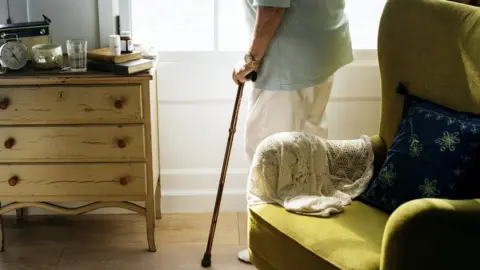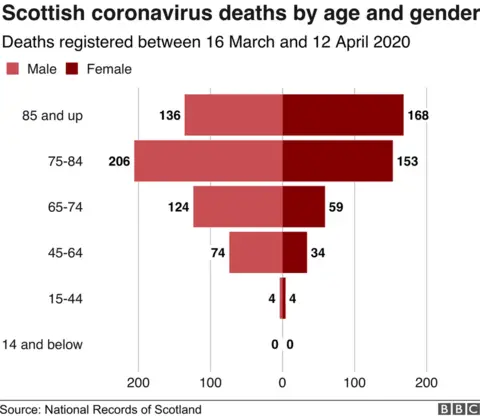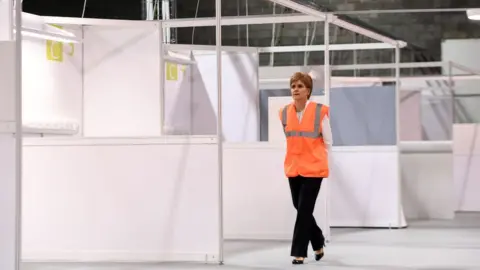Quarter of Scottish coronavirus deaths in care homes
 Getty Images
Getty ImagesA quarter of Scottish deaths linked to coronavirus have occurred in care homes, new figures have suggested.
The National Records of Scotland said 962 deaths had now been registered in Scotland where the virus was mentioned on the death certificate.
The majority of these deaths occurred in hospital, but 25% were in care homes and 13% in other settings.
In the week from 6 to 12 April, the virus was mentioned in 31% of all deaths registered in Scotland.
The NRS figures provide a wider picture of the impact of the virus on Scotland than the Health Protection Scotland statistics which are announced each day.
The HPS figures, which only reflect cases in hospitals where a positive test has been recorded, placed the death toll at 566 on 12 April.
The new NRS figures said coronavirus had been logged on the death certificate in 962 cases - 608 of them in the past week.
Of the total, 596 deaths occurred in hospitals, 237 were in care homes and 128 were in the home or outside of care.
Just under 70% of all registered deaths involving Covid-19 were of people aged 75 or over, and only eight of those who died were aged under 45.

The report also examines which areas of Scotland have been worst affected.
The Covid-19 death rate is 2.7 per 10,000 of the population in Greater Glasgow and Clyde, and 2.6 in the Borders. However, the rate was 0.8 in Grampian and Western Isles had no recorded deaths.
First Minister Nicola Sturgeon said the NRS report provided "a comprehensive figure and therefore a more accurate one".
She said she was "acutely aware" that the figures were "hard to hear" and were "higher than anyone would ever want to think about".
But she said the information was vital in understanding the spread of the virus and informing what to do next.
 Getty Images
Getty ImagesMs Sturgeon said 433 care homes in Scotland had now recorded cases of coronavirus, and stressed that the government was "doing all we can to prevent infection and to control it when there is infection in a care home".
She said moves would be made to test all patients in care homes who were showing symptoms of Covid-19.
However, she said guidance to homes was "already very clear", and that isolation and social distancing remained "the most important factor" in managing and preventing infection.
And she stressed that "none of us are powerless" in the face of the virus, as "all of us have some control here" by following lockdown rules.
The provisional total number of deaths in Scotland for the week up to 12 April was 1,969 - "much higher" than the average for the same week over the last five years, which was 1,100.
Ms Sturgeon said that while much of the increase could be attributed to the virus, "not all of it can". She said this was a "very serious issue for us to look into and explore further".
The first minister also said 1,748 people were currently in hospital with the virus, 195 of whom are in intensive care.
Both of these figures are down on recent days, which she said was "cause for some very cautious optimism".

How is this different from the daily data?
The figures announced each day by the Scottish government come from Health Protection Scotland (HPS), and reflect coronavirus cases which have been confirmed by laboratory testing.
This daily figure reveals how many people have died within 28 days of testing positive for the virus.
The wider figures which come out on Wednesdays are from the National Records of Scotland, and capture a bigger picture.
They include all cases where Covid-19 is mentioned on a death certificate - even if the patient was not in hospital and had not been tested, and even where the virus is a "suspected" cause of death or one of a number of factors.
This is why they are referred to by NRS as cases "involving" coronavirus - the data captures all deaths where the virus was a confirmed, suspected or probable cause of death, either as an underlying cause or directly contributing to it.
As well as being wider, these figures are also broken down in more depth than the HPS ones, with extra figures including the age range of those dying, their gender, where they were in the country, and whether they were in hospital, a care facility or at home.
